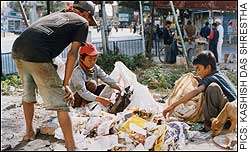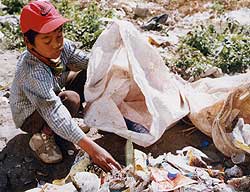 They are there, but most of us don't care to notice them. Ragtag bands of street children sleeping outside bakeries, rummaging through garbage, loud and sometimes raucous children begging from tourists, or inhaling glue out of old milk packets.
They are there, but most of us don't care to notice them. Ragtag bands of street children sleeping outside bakeries, rummaging through garbage, loud and sometimes raucous children begging from tourists, or inhaling glue out of old milk packets.
The problem seems so overwhelming that most of us look the other way, troubled by our own conscience. "But," we try to justify to ourselves, "what can we possibly do. Where do we even start to make a difference?"
Others have started making an effort either by buying the children clothes or food or by counseling them on work and earning. Street children are a popular cause with many charity groups in Kathmandu, but the relief hardly compares to the enormity of the problem. And what little is being done is exacerbated by the new influx of families, or school-age children fleeing the conflict areas, or forced recruitment by Maoists.
 So we went to find out how they live, what they eat, how they pass their time, how they landed up in the streets. They are nearly all boys. The recent Maoist-related influx ha swelled the numbers of street children ("khateys") who were already here. All family members must work to survive, but jobs are hard to find and the younger ones end up in the streets to fend for themselves.
So we went to find out how they live, what they eat, how they pass their time, how they landed up in the streets. They are nearly all boys. The recent Maoist-related influx ha swelled the numbers of street children ("khateys") who were already here. All family members must work to survive, but jobs are hard to find and the younger ones end up in the streets to fend for themselves.
The families can't afford school fees, even though back in the village most of the children went to school. Some have either left their families or their families have deserted them. Their parents simply can't afford to feed them any longer. Caught in a dead end with no education and no work, the children end up where we see them: blackened with soot and warming themselves at a trash heap.  A few maintain ties with their families, but they seldom return to the fold. Many have got used to the freedom of the streets and can't adjust to the structure and discipline of childrens' homes. Many complain of ruthless bullying from older children in the rehab camps, and run away again.
A few maintain ties with their families, but they seldom return to the fold. Many have got used to the freedom of the streets and can't adjust to the structure and discipline of childrens' homes. Many complain of ruthless bullying from older children in the rehab camps, and run away again.
Kuntey runs around with a group of boys in Pulchowk. He had once stayed at the Child Workers in Nepal (CWIN) shelter. "The kids didn't want us there and gave us trouble so I decided to leave," he said. They would rather sacrifice regular meals and a roof over their heads than relinquish whatever control they have over their lives.
Today, Kuntey and his friends are a close-knit group of children between 8-16 years. Their activities concern survival-survival from hour to hour, day to day. "I'll work and live. That's it," says Kuntey's friend who looks 10, but claims to be 16.
 The boys work hard to make a little money. Begging works sometimes, but mostly they have learnt to forage through piles of garbage, clean up and eat anything edible, and sell anything usable. The fog is still thick, and the street lights are still on when they set off early in the morning from their cardboard shelters in Pulchok. The best pickings are in Patan, Satdobato and Jawalakhel and they fan across the town trying to be the early birds. When their sacks are full, they return to base.
The boys work hard to make a little money. Begging works sometimes, but mostly they have learnt to forage through piles of garbage, clean up and eat anything edible, and sell anything usable. The fog is still thick, and the street lights are still on when they set off early in the morning from their cardboard shelters in Pulchok. The best pickings are in Patan, Satdobato and Jawalakhel and they fan across the town trying to be the early birds. When their sacks are full, they return to base.
Plastic waste is separated into simple plastic sheeting and hard plastic. The two are often mixed during recycling, but the junkyards insist on buying it separately. Having finished their morning scavenging, the boys sit together to separate their collection. The going rate is Rs 5 per kg of plastic waste. Metal fetches a higher price. Pieces of metal are hard to find, and the boys consider themselves lucky if they chance upon copper cable. They melt the plastic insulation off the wires and then hammer the wires into heavy little balls. "It increases the weight," Kuntey says as he shows me his hoard.  What they eat and when depends on the generosity and the whims of passersby. They often have to make do with whatever they find in the garbage, but there are times when they get a handout from a nearby restaurant, or leftovers from a party. This morning, Kuntey has found a sausage, and we overhear him telling his friend: "Eat this. It's a buffalo's penis, and it's really tasty." Beaten rice or chiura with sugar is a real treat. One of them found a bag of sugar and everyone had "really, really sweet tea" that day.
What they eat and when depends on the generosity and the whims of passersby. They often have to make do with whatever they find in the garbage, but there are times when they get a handout from a nearby restaurant, or leftovers from a party. This morning, Kuntey has found a sausage, and we overhear him telling his friend: "Eat this. It's a buffalo's penis, and it's really tasty." Beaten rice or chiura with sugar is a real treat. One of them found a bag of sugar and everyone had "really, really sweet tea" that day.
Kuntey's group would probably survive at this rate until they grow older. But they have picked up the habit of sniffing glue. The children tell me it makes them feel happy and disregard the cold and hunger. But when we ask them more questions, they don't want to talk about it. White glue is easily available, the shopkeepers who sell it to the boys have no qualms about it. They pour out a little into old milk packets and inhale the fumes. Kuntey's friends know it's worse than smoking cigarettes, but glue is addictive and their glassy eyes tell us it's going to be difficult for the boys to give it up.


